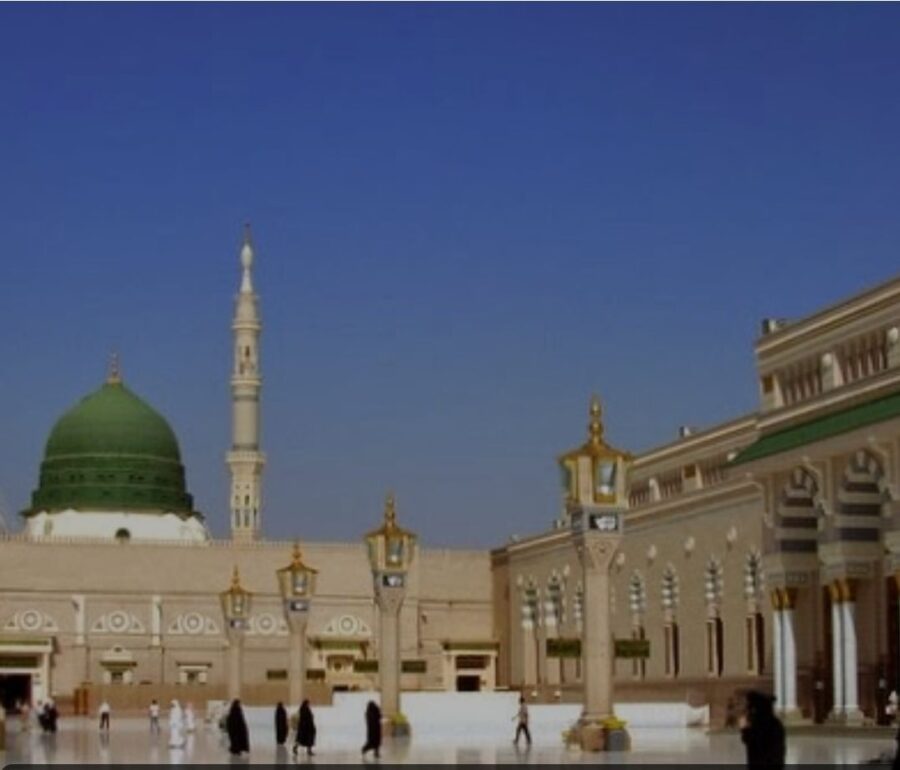Since its inception, the Prophet’s mosque in Madinah has functioned as a community development center.
It performed numerous religious, educational and socio-political roles and functions.
It was a center for religious activities, a learning center, the seat of the Prophet’s government, a welfare and charity center, a detention and rehabilitation center, a place for occasional medical treatment and nursing, and a place for some leisure activities.
Concerning the notion of the mosque partly functioning as a detention and rehabilitation center, many aspects of such a role remained shrouded in a number of ambiguities.
Not only were male captives kept in what can be dubbed as the mosque’s detention center, but also female ones.
For the latter, an enclosed space near one of the mosque’s entrances was designated.
Furthermore, it is reported that a man called Thumama Ibn Uthal from the Bani Hanifah clan in Najd was captured and fastened to one of the pillars of the mosque.
However, the Prophet (PBUH) later ordered some of his people to release him.
The man thereupon went to a garden next to the mosque, took a bath, and entered the mosque proclaiming shahadah, i.e., he embraced Islam.
But, Why Within the Mosque?
The benefits of having a detention center within the mosque’s realm were two-fold.
First, it ensured the safety and fair treatment of internees – generally war prisoners.
Secondly, it helped them to slowly and via some hands-on experience come to terms with what Islam and the Muslims were all about and what they really stood for, taking into account the mosque’s both spiritual and societal significance.
Many of the detainees were won over by the life and demeanor of the Muslims and eventually accepted Islam.

In other words, the place was not a detention center per se.
Rather, it was a spiritual and psychological rehabilitation center never excluded from the ever-increasing scope of da’wah (propagation of and calling the people to Islam).
As a matter of fact, every detention center will function as a rehabilitation center as well.
There is no point in sending a person to a detention center as a criminal or an offender, but when he or she comes out, after serving his or her due sentence, the same person comes out still as a criminal and very soon relapses into criminal behavior.
A person is to go to a detention center as a criminal or an offender, but when he or she comes out, he or she should come out as a rehabilitated and a normal positive thinking citizen.
When Thumama Ibn Uthal – whom we have mentioned earlier – embraced Islam, having spent a couple of days tied in the mosque as a prisoner, he said to the Prophet (PBUH):
“By Allah, there was no face on the earth more hateful to me than your face, but now your face has become to me the dearest of all faces.
By Allah, there was no religion more hateful to me than your religion, but now your religion has become the dearest of all religions to me.
By Allah, there was no city more hateful to me than your city, but now your city has become the dearest of all cities to me.” (Muslim)
The first person in Islam who is believed to have had real detention centers was the fourth caliph, ‘Ali Ibn Abi Talib.
As for the three of his predecessors, Abu Bakr, ‘Umar and ‘Uthman, they followed the custom of the Prophet (PBUH) in making the principal mosque function as a detention center.
Of the three, only ‘Umar is said to have once bought a house in Makkah to function as a detention center.
He bought it from a companion of the Prophet (PBUH), Safwan Ibn Umayyah, for four thousand dirhams.
Even this, however, was nothing new.
During the time of the Prophet (PBUH), the house of Ramlah bint al-Harith al-Najjariyyah, apart from serving as one of the houses in which some of the Prophet’s guests or visiting delegations used to be accommodated, once served as an interim detention center too.
In it, the members of the Jewish tribe Banu Qurayzah — around seven hundred in all — were imprisoned after the judgment that their men were to be slain, their property to be divided, and their women and children to be made captive had been passed on them, until the same was executed at least one day later.
The Prophet (PBUH) gave Banu Qurayzah this treatment because of their treacherous acts against the Muslims during the petrifying battle of the Ditch (al-khandaq), when the very existence of Islam and the Muslims was put in jeopardy, in spite of all the peace and collaboration treaties that existed between the Muslims and the Jews.



